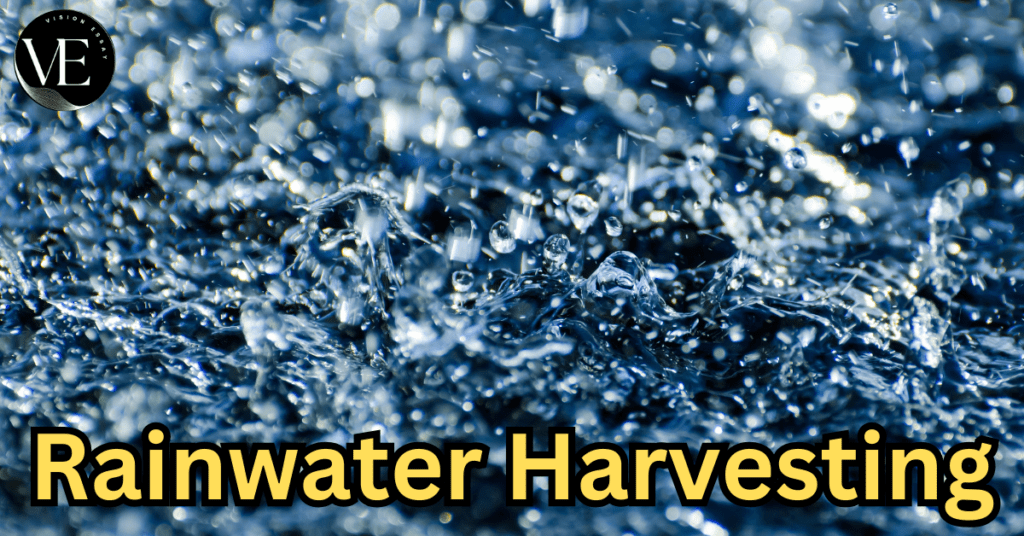Rainwater Harvesting

Introduction
The Jal Shakti Ministry has received ₹98,418 crore from the Interim budget of 2024, an increase over the ₹96,549 crore allotted in the previous budget. Let’s attempt to comprehend the significance of rainwater harvesting and its implementation to ensure sustainable water management.
What is Rainwater Harvesting?
Rainwater harvesting is the technique of gathering, holding, and using rainwater that falls on surfaces like rock catchments, rooftops, and land surfaces. In areas where water shortage is an issue, this approach aims to lessen dependency on conventional water sources like groundwater or municipal water supply.
What are the Various Methods of Rainwater Harvesting?
- Rooftop Collection: Rainwater collected from rooftops is first channeled into gutters and downspouts, and subsequently stored for later use in cisterns or storage tanks. These storage tanks may be partially submerged, subterranean, or above ground.
- Surface Runoff Collection: Using this technique, rainfall is gathered from surfaces like roads and lawns and directed into ponds or barrels for storage.
- Rock Catchment Systems: Rainwater can gather in artificially created or naturally occurring depressions on rocky terrain.
- Stormwater Management Systems: In urban locations, rainwater may be gathered and held in bigger stormwater management systems for use in non-potable applications such as irrigation and groundwater recharge.
What are the Benefits of Rainwater Harvesting?
- Conservation of Water Resources: Rainwater collection lessens the need for conventional water sources, especially in arid regions or during dry seasons.
- Cost Savings: Rainwater harvesting reduces the demand for treated municipal water and lowers water costs by using it for a variety of non-potable uses including washing, toilet flushing, and irrigation.
- Reduction of Urban Flooding: Rainwater harvesting systems can lessen the danger of floods by collecting and storing rainwater, especially in metropolitan areas where stormwater flow is often more severe.
Why is Rainwater Harvesting Important?
- Reducing dependency on municipal water sources is achieved by rainwater harvesting, particularly for domestic use such as vehicle wash and garden irrigation. This may lessen the strain on infrastructure for treatment and freshwater supplies.
- India has monsoonal rains, which result in dry seasons that are interspersed by concentrated bouts of intense rainfall. During dry spells, collecting rainwater during the monsoon helps fill the gap and lessen the shortage of water.
- Over-extraction of groundwater is becoming a serious dilemma in India. Rainwater collection increases water security and sustainability by replenishing subsurface water.
- Rainwater collection lessens the volume of water that enters drains, easing the burden on drainage infrastructure and averting possible flooding.
- The vast agricultural economy in India is highly dependent on water supplies. Rainwater collection can offer a dependable irrigation source, particularly in regions that are vulnerable to drought.
What Challenges Faced in Rainwater Harvesting?
- To avoid blockages, guarantee appropriate filtration, and preserve storage integrity, rainwater collecting systems need to be maintained regularly. Water contamination can result from maintenance neglect.
- Waterborne illness risk is increased by mosquito reproduction in poorly maintained systems. The best conditions for growth are created by stagnant water in tanks or blocked drains.
- Rainwater harvesting capability may be limited by space constraints, financial constraints, or legal restrictions.
- The advantages of rainwater collection and how to properly apply it are not well known. The absence of education and outreach initiatives may impede the broad acceptance and implementation of rainwater collecting in communities, since they may not be aware of its potential or the best ways to incorporate it into their water management practices.
What are Government Initiatives for Rainwater Harvesting?
- Jal Jeevan Mission: Guarantees sustainable agriculture, water supply systems, and quality control.
- National Water Policy (2012): Directs the development and planning of water resources for optimal use.
- Jal Shakti Abhiyan- Catch the Rain: Seeks to collect rainfall before the monsoon by using check dams, pond restoration, artificial recharge structures, and river rejuvenation.
- Atal Bhujal Yojna: Focuses on water budgeting, water security planning at the Gram-panchayat level, and sustainable groundwater management with community involvement through Water User Associations.
Conclusion
Rainwater harvesting is crucial to India’s future water sustainability. It helps address the issue of water shortage by reducing expenses, conserving resources, and safeguarding the environment. Everyone gains from adopting this strategy, which guarantees India and its communities a more sustainable and greener future.
Frequently Asked Questions(FAQs)
How much does a rainwater harvesting system cost?
A rainwater harvesting system’s price is determined by several variables, including the system’s size, components, and installation difficulty. It is a good idea to look into financing possibilities and get quotations from many companies.
Can rainwater be used for drinking purposes?
Rainwater may be turned drinkable with the right filtering and treatment. Ensuring water purity and adhering to health laws is crucial.
What maintenance is required for a rainwater harvesting system?
Gutter cleaning, leak detection in storage tank inspections, and water quality monitoring are examples of routine maintenance chores. Periodic professional service may be necessary to maintain optimal system functioning.
Is rainwater harvesting legal?
The legality of rainwater gathering differs by location. Before putting a system in place, it is crucial to investigate local laws and secure the required licenses.
Sources:
- https://en.wikipedia.org/wiki/Rainwater_harvesting
- http://www.rainwaterharvesting.org/Urban/Components.htm
- https://economictimes.indiatimes.com/news/how-to/rainwater-harvesting-at-your-home-in-four-simple-steps/articleshow/85366262.cms?from=mdr
- https://pib.gov.in/PressReleaseIframePage.aspx?PRID=1914351
Leave a Reply